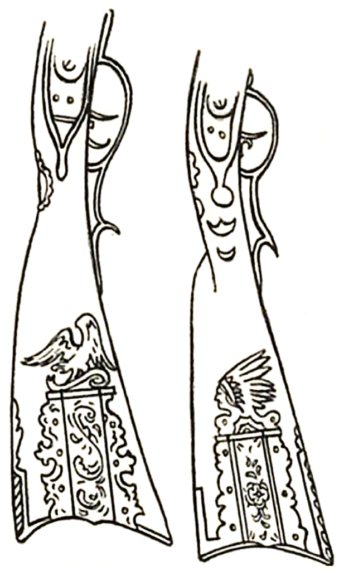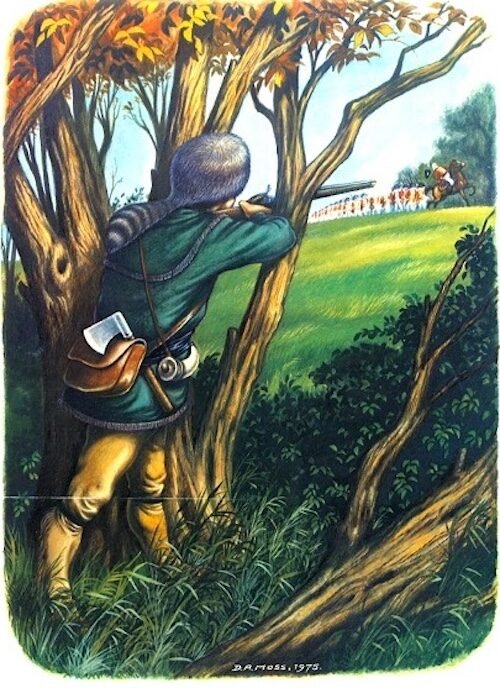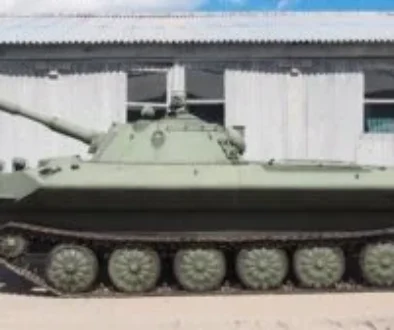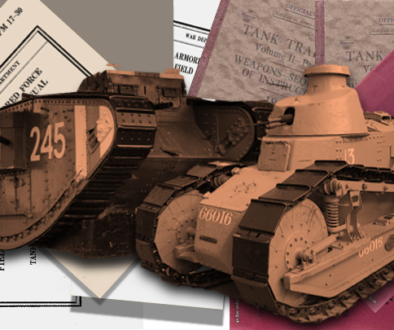‘KENTUCKY’

LONG RIFLE

The Kentucky Long Rifle: Another prominent firearm of the War of Independence illustrated and described by
D. A. Moss

THERE are innumerable legends sur rounding the origins of the rifled barrel and the causes that stimulated experiments in rifling. One is that it resulted from observing the spinning crossbow bolt; another is that the grooves were originally cut to collect the carbon fouling that was inevitable with early powder in the hope that this would ease loading and cleaning. If the latter, the resulting spin on the ball giving greater accuracy was a fortunate discovery
It is generally accepted that it all began in Germany, (the word rifling is from the German “Riefeln” – to groove) the earliest examples appearing around the middle of the 16th century. However, it would be many years before the effect of rifling on the evolution of firearms would be fully appreciated. Due to the slow loading procedure many European commanders deemed the rifle impractical as a military arm, nevertheless small units of riflemen were raised from time to time throughout the 17th century mostly in Germany, Scandinavia and the low countries. But by the time of the Seven Years war most European armies had rifle corps on a regular basis.
In Britain however, little attention was paid to rifling although as early as 1747, Benjamin Robins, a well known mathematician of the time, published a paper entitled “Observations on the nature and advantage of rifled barrel pieces” but his was a lone voice in the wilderness. The hidebound military authorities adhered slavishly to outdated methods. So Britain wasn’t to follow suit and establish an official rifle corps until 1800, although several bodies of colonial riflemen had served Britain during the French and Indian wars in North America and Captain Patrick Ferguson’s experimental Corps served briefly during the War of Independence.
The settlers of the 17th century only had the cumbersome and inaccurate smoothbore muskets with which to stave off marauding Indians and supplement their larders. Unless one was successful at getting close to the quarry these guns were no match for the fleet footed deer and elusive redskin. But a new element was introduced when the early part of the 18th century saw the birth of a new all American firearm which would be well established by the 1740s. At the turn of the century, economic, religious, and political pressures brought many German and Palatine Swiss immigrants to the new world.
They mostly settled in Pennsylvania and amongst them were skilled gunsmiths who at first made weapons after the style of the old country. In Europe the rifle was still mainly used for sport and these were adequate for competition shooting or the leisurely hunting of a civilised land, but on the American frontier these rifles were totally unable to meet the requirements of the pioneer. The gun makers soon came to realise the shortcomings of their firearms. What the hunter and farmer required was a rifle that could be more quickly loaded. The ball should be well lubricated by being wrapped in a greased patch of leather or cloth, making easier and; more rapid loading possible with the ramrod alone.
The rifle must have a smaller bore that would use small charges of powder and lead, as an ample supply of these had to be carried on the person for long periods at a time. The woodsman often covered vast distances on foot and for this reason the rifle had to be lightweight.
It also must be a firearm that balanced well for accurate off-hand shooting. The small bore barrel should contain as much metal as was reasonably possible to absorb some of the sound when fired; too loud a report could attract the unwelcome attention of Indians.
The pioneer and the gunmakers consulted and experimented, constantly making changes as experimentation dictated and between them by the late 1720s they were beginning to produce the first native American rifles. The business must have become traditional with many families because a hundred years after their forebears began the manufacture of long rifles, the names of third and fourth generation American gunsmiths were still predominantly German.

Typical examples of butt box decoration
There were many gunmakers with varying degrees of skill working in small manufacturers so, of course, these weapons differed in quality and style during the one hundred and twenty years of their reign. But a typical example from the late 18th century when these arms were at their zenith could be described as follows. The overall length of the rifle varied usually between five and six feet and weighed from 9 to 10 lbs. They had a full or half octagonal barrel usually 42 to 47 but occasionally 60 inches in length. The calibres were mostly from 0.40 to 0.45 – these reduced bores conserved the powder and shot.
The long barrel firing a patched ball weighing ½ oz. also ensured that maximum thrust was attained by all the powder being burned in the barrel, and giving a muzzle velocity of about 1,500 feet/second ensuring a flat trajectory, great accuracy over a distance, and good killing power up to at least 200 yards. The sights were a simple V cut backsight and a blade or bead foresight. Unlike most European soldiers who liked bright barrels the American woodsman retained the protective browning which also served to minimize glare. The early models of American rifle had the barrel firmly pinned to the stock through lugs under the barrel but later the more convenient harnessed sliding pins were used.
In Europe most gunstocks were made from walnut, a wood that was practically unattainable to the gun makers of the new world. So various local woods were tried. Maple was found to be the most suitable and very decorative giving an attractive tiger stripe effect when polished. The slender stock was full length to the muzzle and gave the rifle a graceful appearance.
The forests and plains abounded with wild life of every sort – deer, moose, wolf, bear, catamount, wild pig, buffalo, lynx, beaver, turkey and racoon. The pelt of the last animal often being converted into a picturesque form of headgear popular among the backwoodsmen. Originally, and more correctly this famous firearm was called the American long rifle, although perhaps with some justification it was also called the Pennsylvania rifle after its birthplace. But latterly and most commonly it became known as the Kentucky rifle, a name which has stuck to this day and under this title it has become associated with the exploits of men like Daniel Boone, David Crockett and other such eagle eyed heroes of American folklore.
The reason for the term “Kentucky” rifle is obscure for that state had no outstanding claim as a gun producing region, although it is true that Kentucky, together with Massachusetts, New York, and Ohio did produce some long rifles.
Despite a basic American style common to all these weapons they did acquire regional characteristics which enable modern experts to deduce the locality of a long rifle”s origin. Some of the features that would give clues to the identity of a particular rifle would be in the fancy decoration peculiar to these weapons. The engraved patchbox would be particularly ornate according to the owner’s or maker’s taste. It may be a respectably clad female figure, an American eagle, a trophy of arms or floral design. The box usually had a fretted edge inlaid and pinned into the butt ( there are two examples in the line drawings).
The stock may also be decorated at intervals along its length with a variety of motifs such as stars, crescents etc., and all the furniture would probably be heavily engraved. The metal usually employed was brass but more prosperous owners would have silver inlay. Incorporated into these lavishly decorated pieces would often be rather disappointingly crude trade locks mostly imported from England or Germany. Essential equipment for the rifleman was the leather hunting bag and the cow horn powder flask. The hunting bags were sometimes attractively decorated with Indian beadwork designs and the powder horns often had quite finely etched scenes on them depicting the hunt, or territorial maps, usually dated and accompanied by the owner’s name.
In addition to his rifle the buckskin clad frontiersman always carried a skinning knife and tomahawk. Every American frontiersman was a crack shot, his life depended on it. When the move for independence did come many Americans flocked to join the rebel standard. Among them were the wood-crafty huntsmen and trappers who lived by the gun and who were to prove such a thorn in the British flesh. The war lasted eight years (1775-83) sometimes turning in favour of the King’s men and, at others, the rebels. Not that the war was conducted with any great professionalism or outstanding military skill by either side. But the British in particular had a shock for, although during the early years of the war, the hurriedly raised and ill-equipped American army usually came off worst in any attempt at a set-piece battle with the British regulars.
The American rifleman was a much more formidable problem. The riflemen were careful never to let themselves be caught in open country. They were born and raised in the great American forests and it was their element. In stealth and tracking these irregular soldiers were the equal of any Indian and the almost invisible woodsman fought indian style. Moving from tree to tree and through the undergrowth, sniping with unerring skill and slipping away like a will-o-the-wisp. Astonished Britons were bowled over at distances up to 300 yards. The British employed Hessian riflemen but they were no match for the Americans, being still equipped with the old style German weapons that the American rifles had sprung from.
However. the American long rifle on its own couldn’t win the war. In spite of it being quicker loading than its German ancestor. it still wasn’t as rapid as the smoothbore also it was not designed to take a bayonet. So although the rifleman could hit his foe from a distance he constantly had to give way before the advancing battalions. But as the war progressed the Americans gradually built up battalions equipped with the musket and bayonet. Groups of riflemen were attached to the regulars and they could punish the advancing British. selectively picking them off well beyond musket range.
Many of the British dead were found to have been killed by a single shot in the head or the heart, not by the random fire of the American troops’ smoothbores but by the coolly aimed shooting of the leather clad irregulars and their long rifles. However, continual improvement in other firearms led to the gradual decline in popularity of these beautiful weapons until by the 1850s only a few were still in everyday use. The last long rifles used in military action on any scale were probably at the Alamo in 1836 although possibly a few old timers let fly with them during the Civil War of 1861-65.

Reproduced with kind permission of Doolittle Media



